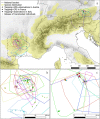Fission-fusion dynamics over large distances in raven non-breeders
- PMID: 28336913
- PMCID: PMC5428508
- DOI: 10.1038/s41598-017-00404-4
Fission-fusion dynamics over large distances in raven non-breeders
Abstract
The influence of fission-fusion dynamics, i.e., temporal variation in group size and composition, on social complexity has been studied in large-brained mammals that rely on social bonds. Little is known about birds, even though some species like ravens have recently received attention for their socio-cognitive skills and use of social bonds. While raven breeders defend territories year-round, non-breeders roam through large areas and form groups at food sources or night roosts. We here examined the fission-fusion patterns of non-breeding ravens over years, investigating whether birds meet repeatedly either at the same or at different locations. We combined four large datasets: presence-absence observations from two study sites (Austria, Italy) and GPS-tracking of ravens across two study areas (Austria, France). As expected, we found a highly dynamic system in which individuals with long phases of temporary settlement had a high probability of meeting others. Although GPS-tagged ravens spread out over thousands of square kilometres, we found repeated associations between almost half of the possible combinations at different locations. Such a system makes repeated interactions between individuals at different sites possible and likely. High fission-fusion dynamics may thus not hinder but shape the social complexity of ravens and, possibly, other long-term bonded birds.
Conflict of interest statement
The authors declare that they have no competing interests.
Figures


References
-
- Humphrey, N. K. In Growing points in Ethology (eds. Bateson, P. & Hinde, R.) 303–321 (Cambridge University Press, 1976).
-
- Byrne, R. W. & Whiten, A. Machiavellian Intelligence: Social expertise and the evolution of intellect in monkeys, apes and humans (Oxford University Press, 1988).
Publication types
MeSH terms
Grants and funding
LinkOut - more resources
Full Text Sources
Other Literature Sources
Research Materials

